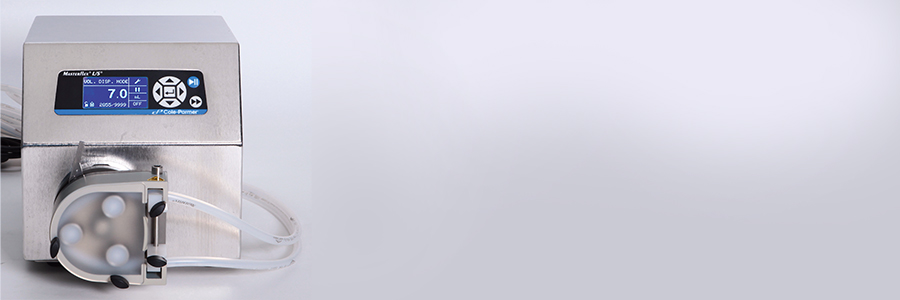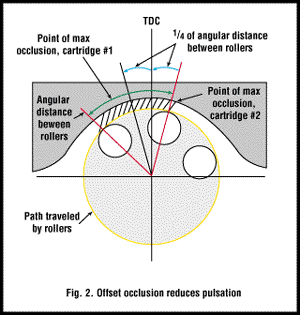How To Reduce Pulsation in Peristaltic Pumps

Some applications for peristaltic pumps are sensitive to pulsating fluid flow. Fortunately, there are many things you can do to help reduce the adverse effects of pulsation.
The following topics will be covered below.
Click on any of these topics to go directly to that part of the page.
What causes pump pulsation

Pump heads are simple machines containing a rotor and its housing, with a pump tube between the two. Fluid can become trapped between two rollers as it enters the head of a peristaltic pump. The trapped fluid forms a "pillow," followed by a void where rollers inside the pump head occlude the tubing. Alternating pillows and voids can cause the fluid flow to pulsate rather than be smooth and continuous. (Figure 1)
Using a pump head with adjustable occlusion can lessen pulsations by 25% when occlusion is reduced. That is because reducing occlusion creates less distinction between fluid pillows and voids. Some applications are more sensitive to the pulsating flow produced by peristaltic pumps and may require reducing the frequency of pulsations by more than 25%. There are four other methods you may consider to further reduce pulsations. They are:
- Using pump heads with offset occlusion and multiple-roller design
- Mounting multiple pump heads at an offset
- Using a pulse dampener
- Changing the configuration of the discharge tubing.
Creating a low-pulse peristaltic pump
By adding a few parts, lab technicians can help reduce pulsation in peristaltic pumps. Pulsation dampeners and multiple pump rollers are two options. Each option is described below.
Pulse dampener for peristaltic pump
A pulse dampener can be inserted into the discharge line to reduce pulsation. Dampeners create a trapped air pocket in the tubing, above the fluid. As pulsating fluid travels through the discharge line, the trapped air can absorb as much as 90 percent of the pulsations to create a smoother fluid flow.
Pulse dampeners can be easily fabricated for all tubing sizes by using a retaining vessel and appropriately sized tube fittings. The fluid inlet and outlet should be located near the bottom of the vessel to trap air at the top. The outlet of the dampener vessel should be at the same height as, or lower than, the inlet to reduce dead volume.
You can also help reduce pulsation by changing the configuration of the channel the tubing flows through. Making the length of the discharge tubing several times longer and selecting a softer tubing material, such as silicone, can reduce pulsation by as much as 60%. Softer tubing helps absorb fluid pulsation, and a longer discharge line increases friction. The increased friction raises back pressure, compressing the pulses together to reduce pulsation.
Multiple pump rollers
Many peristaltic pump heads include two or three rollers, with the point of maximum occlusion at the top dead center (TDC) of the pump head (Figure 1). Other pump heads use six or eight rollers and are designed with the point of maximum occlusion rotated away from TDC (Figure 2). That is called offset occlusion. Combining these two pump head designs can almost eliminate pulsation.

Technicians can also mount two cartridges (or tubing beds) with offset occlusion in opposite directions of the pump head so their respective points of maximum occlusion are on opposite sides of TDC.
The inlets and outlets of each channel can be joined with Y-connectors, so fluid pulses arrive alternately at the Y-connector on the outlet side. Because the pillow and void volumes are nearly identical with a six- or eight-roller pump head, the pillow from one channel almost evenly fills the void in the opposite channel. This technique may increase the frequency of pulses, but it also lowers the amplitude of pulsation. The result is a nearly pulseless flow (Figure 3). This solution is ideal for 460 ml/min flow rates or less.

The same principle of offset occlusion can be applied to flow rates above 460 ml/min but may be less effective. Pump heads with maximum occlusion at TDC can be coupled, provided coupling allows the rotors to be offset from each other.
The optimum conditions for minimizing pulsations occur when the pump heads are offset by 50% of the distance between rollers. That keeps the pump rollers from reaching TDC simultaneously and alternates the pillows and voids from the two pumping channels. If the inlets and outlets of each channel are joined with Y-connectors, the pillow from one channel fills the void from the other channel. Because these pump heads produce a larger pillow-to-void ratio than those with six or eight rollers, pulsation is reduced by only 80-95%.
Reducing pulsation in peristaltic pumps
Reducing pulsation in peristaltic pumps can help keep them working efficiently and make them last longer. Masterflex® peristaltic pumps are designed to minimize pulsation, but in the uncommon event you do encounter such problems, the above mitigation techniques can help.
Contact us today to discuss the pump, head, and tubing options available to meet your needs.